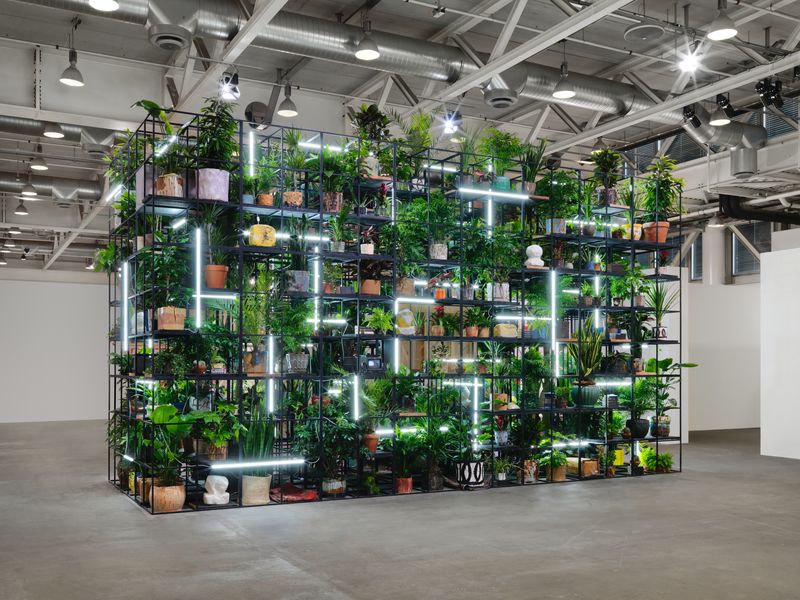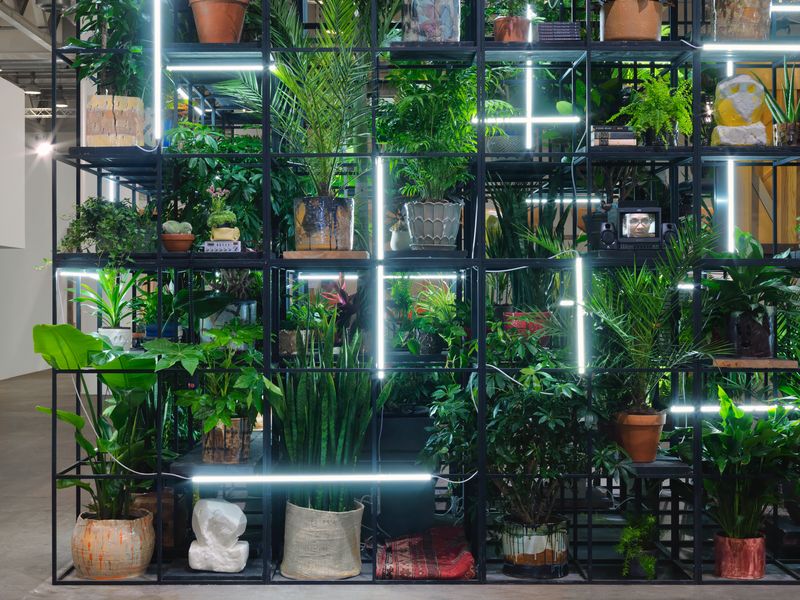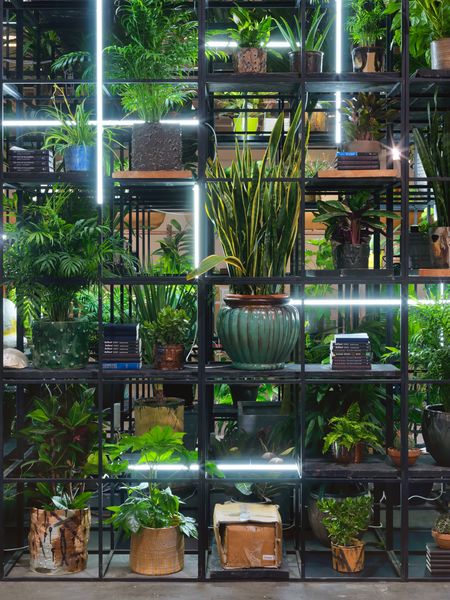Rashid Johnson introduces 'Antoine's Organ'
Films
Rashid Johnson at Unlimited
Art Basel 2018
- 10 June 2018
Unlimited, Art Basel 14 – 17 June 2018
- Related Artist
- Rashid Johnson
Rashid Johnson’s large grid installation 'Antoine’s Organ' (2016) injects a sprawling, heterogeneous ecosystem into a rigid armature of black steel scaffolding. Visually evoking prison cells and Sol LeWitt’s open Minimalist cubes alike, 'Antoine’s Organ' plays on the structure of the grid and the form’s associations with containment, rigor, and organization.
Building upon these constraints as it subverts them, Johnson’s latticed construction teems with a lively bricolage of potted plants, shea butter busts, video monitors playing looped films, ornate rugs, music, carefully selected stacks of books, and a fully functioning piano. Johnson’s soaring sculptural installation functions through organic accumulation, growth, and the delight of unexpected elements meeting.

Rashid Johnson, Antoine's Organ, 2016. Installation view, Unlimited, Art Basel, Basel, 2018. © Rashid Johnson
Urged on by the artificial glow of the installation’s grow lights, a variety of tropical plants – from ferns to ficus – spring from ceramic vessels that have been hand-built and decorated by Johnson. In addition to an array of luscious drips, scratches, and folds, these pots feature major motifs from Johnson’s work including the crosshairs symbol of 'Black Steel in the Hour of Chaos' (2008) and the frenetic faces of the Anxious Men series (2014 – present). Unctuous blocks and rough-hewn busts made of shea butter, an African-sourced balm that has become one of Johnson’s signature materials, serve as an additional sculptural element of 'Antoine’s Organ.' Shea butter became popular as a moisturizer in the African-American community in the 1970s, and was a fixture in Johnson’s childhood home. Indeed, the artist’s interest in Afrocentrism and the material, intellectual, musical, and literary underpinnings of his Afrocentric upbringing in the 1970s and 1980s Chicago suburbs serves as source material for much of his work.

Rashid Johnson, Antoine's Organ (detail), 2016. Installation view, Unlimited, Art Basel, Basel, 2018. © Rashid Johnson

Rashid Johnson, Antoine's Organ, 2016. Installation view, Unlimited, Art Basel, Basel, 2018. © Rashid Johnson
Yet another signifying sculptural element, the piles of literature in 'Antoine’s Organ' were carefully chosen by Johnson for their appearance and content. Spanning time periods and genres, these books examine tensions, issues, and experiences as they relate to race and class. The stacks include such celebrated Afrocentric texts as Paul Beatty’s The Sellout, Randall Kennedy’s Sellout: The Politics of Racial Betrayal, W.E.B. Du Bois’s The Souls of Black Folk, and Ta-Nehisi Coates’s Between the World and Me. Johnson’s literary selection suggests the sheer breadth and depth of black experience in America, as well as the wealth of African-American literary output and cultural production. At the beating heart of the labyrinthine work is an upright piano, partially concealed above the viewer and behind the leaves. During the 2016 exhibition 'Fly Away' at Hauser & Wirth in New York, the installation featured performances by the classically trained pianist and music producer Antoine Baldwin (also known as Audio BLK). As Baldwin played the aerial piano, melodies floated through the foliage. (In exhibitions at the Kemper Museum of Contemporary Art and Milwaukee Art Museum, local musicians activated the work in lieu of Baldwin.) The music continuously activated the work, implying the life-giving power of music in conveying narrative and cohering communities – notably, black communities.

Rashid Johnson, Antoine's Organ (detail), 2016. Installation view, Unlimited, Art Basel, Basel, 2018. © Rashid Johnson
'Antoine’s Organ' is an experiential installation that verges on stream-of-consciousness in its unique constellation of signs. It proposes that the dominant cultural canon is capable of being reimagined, rewritten, and reconfigured; that knowledge, cultivated through organic and constructed means, can look and function differently from anything previously envisioned. In giving Johnson’s lived and cultural experiences an external form, 'Antoine’s Organ' breathes life into art’s methods and concepts. Crucially, as feminist author and activist bell hooks wrote, ‘Changing how we see images is clearly one way to change the world.’ (1) 1) bell hooks, Reel to Real. Race, Sex, and Class at the Movies, New York NY: Routledge, 1996, p. 6
